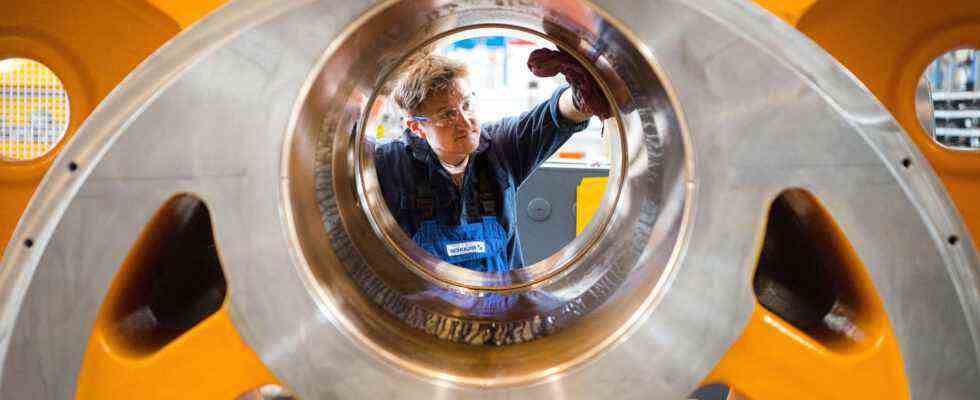Status: 01.01.2022 5:18 p.m.
Inflation is high, as are producer prices in Germany. While the ECB expects the high rate of inflation to be temporary, some experts fear an “inflationary regime”.
Jens Pohlmann walks through the abandoned company hall of his company with a satisfied smile. The workforce is on vacation between the years. ProContur in Wittlich in Rhineland-Palatinate produces sheet metal and plastic products. The customers range from medical technology to electric mobility. “We have grown a lot this year – despite the many challenges posed by Corona. We were able to compensate for the lack of material for the time being. But the resulting increase in prices will stay with us for a long time,” says Pohlmann while looking at his machinery.
Strongest price increase since the 1970s
The massive price jumps started in mid-2020 a few weeks after the first lockdown, the company boss recalls. “At that time a kilo of galvanized steel cost 70 cents. In the summer of this year we were already doubling it, and in the autumn the price was even 2.40 euros. With our prices we had to follow some of our prices.” He was surprised, however, that customers continued to order a lot despite rising costs. “I didn’t expect that and I haven’t seen anything like it before.”
Pohlmann’s experiences can also be seen in the nationwide statistics. According to this, the producer prices of commercial products were 19.2 percent higher in November than in November 2020. According to the Federal Statistical Office, that was the highest increase since 1951. To put it into perspective: the rebuilding of war-torn Germany began at that time. According to the Federal Statistical Office, energy costs are still mainly responsible for the increase.
Many industry associations and economic experts expect that the supply chains will work again in the next year and that there will be enough material for the industry. The price increases should then also subside. But Pohlmann no longer believes in a return to the times before Covid. “This is likely to continue at a different price level in the future. If the automotive industry really gets going again, the prices for our materials will also rise.”
ECB: inflation is only temporarily high
For the European Central Bank (ECB), the price trend is nothing to worry about. “Inflation should decline over the coming year,” said President Christine Lagarde. However, when it presented its inflation figures, the ECB had to make significant adjustments to its previous forecasts. For 2022, an inflation rate of 3.2 percent is now expected. So far the value was only 1.7 percent. From 2023 the value should then be 1.8 percent. The rise in energy costs should calm down in the long term, and with it inflation, hopes Lagarde.
In Munich, Hans-Werner Sinn also listened carefully to Lagarde’s statements. “After the ECB has almost doubled its old forecast values, I think the ECB’s inflation forecast for 2022 is reasonably realistic. This high inflation means a high loss of purchasing power. Wage earners, pensioners and savers are badly affected,” says the former president of the economic research institute Ifo .
“Step into an inflationary regime”
In contrast to the ECB, Sinn fears long-term inflation and gives several different reasons for this: “The unions will demand compensation in the wage negotiations in 2022, which will then drive inflation further into 2023. There are also pull-forward effects. Consumers want durable goods Buy quickly before it gets more expensive. Demand is increasing and that is fueling inflation again. ”
In addition, Sinn sees permanent structural reasons for persistently high inflation – for example due to the energy transition. “No other country in the world is pushing the switch to more expensive green energies with such force as Germany. After a decade of more or less stagnating price developments, we are now entering an inflationary regime that is reminiscent of the 1970s.”
Inflation as a means of fighting debt?
This development does not come as a surprise to the economist. He had spoken about it in a speech a year ago, when inflation was still very low. “During the Corona crisis, we had huge government stimulus programs that we have never seen before. At the same time, there was lockdown, which led to the supply shortage because there was no longer as much production,” said Sinn.
But why then does the ECB see no risk of permanently high inflation and continue with its loose monetary policy? “There are statements from the top of the ECB to solve the debt problem in the south of the euro area with the help of inflation. With the devaluation of the money, the debts should also be devalued,” explains Sinn.
“Other high-ranking experts such as the former chief economist of the ECB, Ottmar Issing, and former central bank chiefs, have voiced the suspicion that the ECB is keeping interest rates so low because it wants to protect the over-indebted countries in the euro zone from burdens,” explains Sinn. Such motivations, however, meant a violation of the Maastricht Treaty mandate to keep the price level stable, the expert warns.
The rise in prices for medium-sized companies is likely to continue
In Wittlich, entrepreneur Pohlmann locks the door to the company premises. 2021 went well for ProContur, but what will the next year bring? “Our electricity costs will go up by around 100,000 euros per year. That is an enormous burden. We will also have to compensate for that with our prices. We will not be the only ones. Electricity is everywhere in the economy and therefore also increasing Prices. ”
Contrary to the predictions of the ECB, he does not see any easing on the inflation front. “I am not an economist and only judge it from my experience: The price screw is no longer turning back. I would see an inflation rate of three to five percent as normal for the coming year.”

